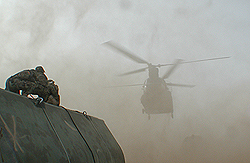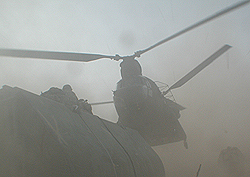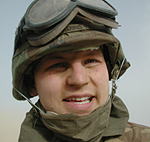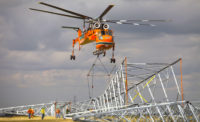On Monday, March 24, the unit repaired to Camp Udairi, in Kuwait, to sling-lift a dozen floating bridge components-- bays and ramps -- via helicopter to a staging area inside Iraq. A parade of helicopters was scheduled to descend on the field at Udairi to hook up the six-ton units and pluck them away, one after the other. The role of the 502's crew at the pick-up site was to rig the units with harnesses and attach them to the big CH-47 "Chinook" helicopters as they hovered overhead.
In any environment the process of hooking slings to the bottom of a huge helicopter hovering over your head would be a heart-thumping challenge, but on the desert sands of Kuwait, adding boiling clouds of blinding dust to the hurricane force winds under the rotors raises it to an feat of extreme difficulty. Most of the hook-ups that day took multiple tries and long minutes of dust churning hovering to pull off. In some cases, after several attempts failed, the choppers set down so crews could get out and discuss technique with the handlers on the ground.
For the ground crew, the hook-up is a multistep process. A crew of three stands atop the bay to be lifted and awaits the helicopter's approach. When it comes within reach, the center person reaches up with a static probe, a rod with an insulated handle that is attached by cable to a grounding stake driven into the ground. He hooks the probe onto the helicopter to take off the static charge as the chopper settles down on top of him.
The high-voltage, low-amperage jolt shoots a blue bolt several inches across the gap. If crewmembers are unfortunate enough to touch any part of the aircraft prematurely, the shock will jump through them instead. It doesn't kill, but it sure can hurt, they say. They also say it happens all the time.
Then the sling handlers reach up and drops loops of line for the harnesses onto hooks under the bottom of the aircraft. The hooks have remote releases in case of trouble. The whole process is observed by a helicopter crewman who advises the pilot on adjusting the hovering as he peers down through a hole in the belly of the machine.
As soon as the harness is looped on, the crew slides off the bay and runs for it, blasted away by the deafening rotor wind.
 |
 |
 |
 |
 |
 |
 |  |
IDS:
Specialist Brett Harris (left), Neola, Utah. And Staff Sergeant Alfred McMillian, Birmingham, Ala.
![]()
 |
ENR Associate Editor Tom Sawyer filed this story and others from Iraq while embedded with Engineer Brigade of U.S. Army's Third Infantry Division.
he 502 Engineer Co., part of the 565 Engineer Battalion, headquartered in Hanau, Germany, is equipped with the tools and expertise to throw a variety of floating bridge units across everything from modest streams to major rivers in a matter of hours; even minutes.

Post a comment to this article
Report Abusive Comment